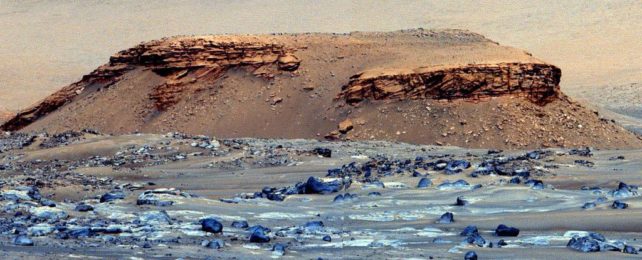The Perseverance rover may have just found evidence of organic compounds in the rocks of the Jezero Crater.
Previous studies have found evidence of organic compounds on Mars before. The Curiosity rover and the Mars Express orbiter both returned evidence thereof, as has data from Perseverance. None of it necessarily implies some kind of biology – a variety of geological phenomena can facilitate carbon-based chemistry, after all.
But studying these compounds in greater detail could reveal more about the water history of Mars, and whether or not the Red Planet could have at least once played host to some kind of living processes.
Obtained from two different sites in the crater, the minerals contain evidence of aquatic processes that carve out perfect little hollows for cooking up some organic chemistry. Based on one kind of analysis, they may even contain traces of carbon-based compounds.
The Jezero Crater was, many eons ago, a much wetter place than it is today. There are still traces of the ancient river delta that once fanned out across the crater floor. Interactions between water and rock can result in the formation of organic compounds of the kind already found in the ancient delta.
However, whether there are also organic compounds elsewhere on the crater floor has been an open question. Scientists expected that the rock found therein would largely be sedimentary, deposited by water long ago – but, when Perseverance arrived, we learnt that much of the crater floor was volcanic, not sedimentary.
Using Perseverance's Scanning Habitable Environments with Raman and Luminescence for Organics and Chemicals (SHERLOC) instrument, an international team led by planetary scientist Eva Scheller of Caltech and MIT conducted a probe of igneous rocks in the crater floor.
They used deep ultraviolet Raman and fluorescence spectroscopy on three rocks from two sites in the crater, and found signs that significant contact with water had altered the rocks.
There was evidence of two kinds of alteration, which suggested two distinct different aqueous environments, at different times in the distant past.
First, reactions with liquid water resulted in the formation of carbonates in igneous rock that was rich in olivine around 3.8 to 2.7 billion years ago.
Later, between around 2.6 to 2.3 billion years ago, briny water rich in salt could have induced the formation of sulfate-perchlorate (salt) mixes in the rocks.
Both carbonates and perchlorates require water to enter the rocks, dissolving and depositing minerals in hollows carved out by water erosion. It's unlikely that water has touched the rocks since the perchlorates were deposited, as perchlorates dissolve easily.
In all three of the rocks, the team found fluorescence signatures consistent with aromatic organic compounds similar to benzene. These seem to be preserved in minerals related to both aqueous environments, the researchers say, but we can't yet tell what they are.
"Collectively, the data show the drilled samples collected by Perseverance from the floor of Jezero crater are likely to contain evidence for carbonation and formation of sulfates and perchlorates," they write in their paper.
"Fluorescence signatures consistent with organics present within these materials indicates an interplay between igneous rocks, aqueous alteration, and organic material on Mars."
Perseverance has long since moved on from the sites at which these data collections were conducted. Fortunately it also collected samples of the rocks themselves, in the event they might be ferried home to Earth later on a mission that has yet to launch.
"I hope that one day these samples could be returned to Earth so that we can look at the evidence of water and possible organic matter, and explore whether conditions were right for life in the early history of Mars," says geochemist Mark Sephton of Imperial College London in the UK.
So it'll be a while until we have the confirmation we crave. But getting those rocks into an Earth laboratory, with equipment capable of studying the compounds in detail, could tell us more about the past habitability, or non-habitability, of Mars.
In the meantime, Perseverance, continuing its slow perusal of the Jezero Crater, may pick up some stronger clues.
We just have to wait and see.
The research has been published in Science.
